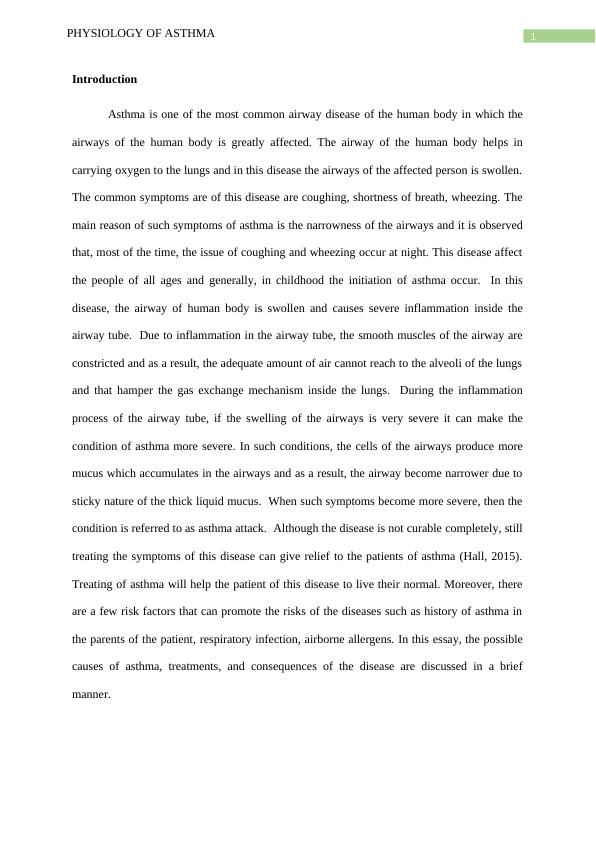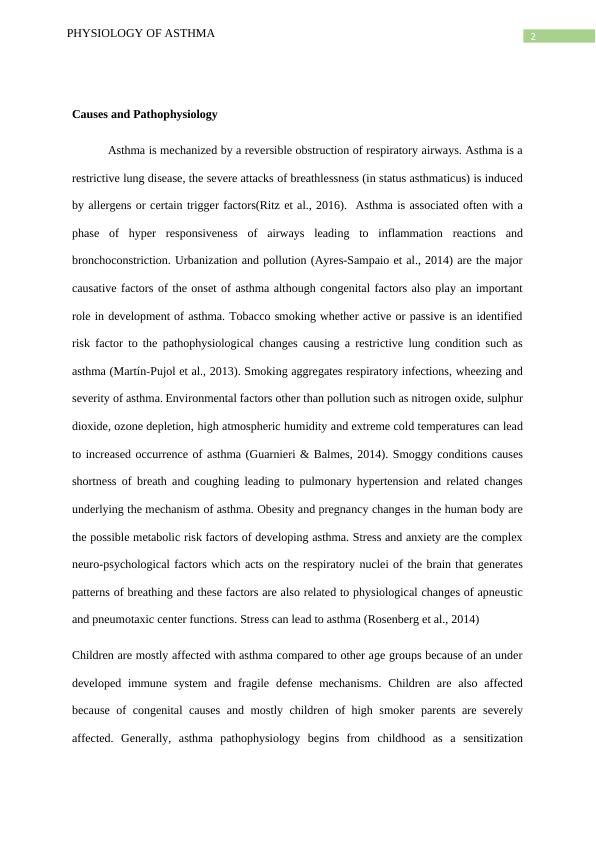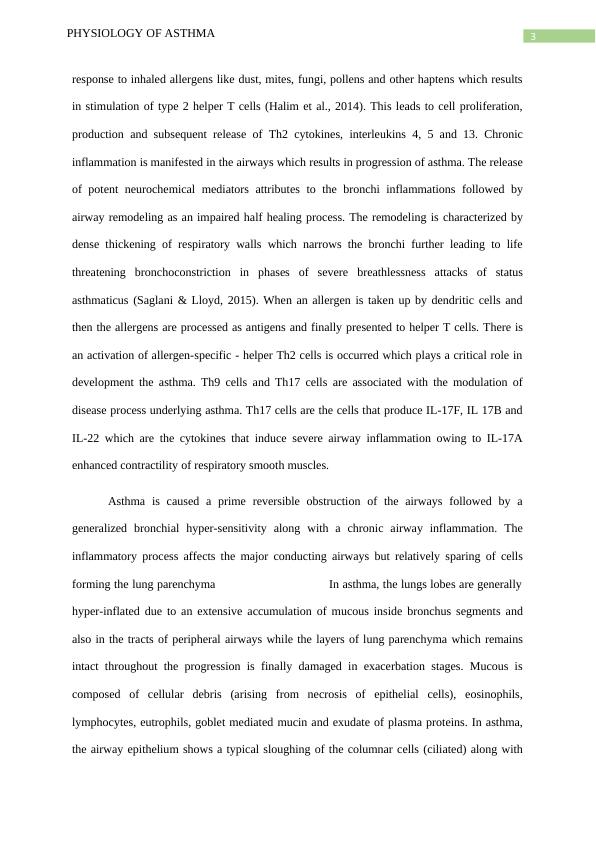Physiology of Asthma
Added on 2023-01-19
12 Pages3575 Words32 Views
Running head: PHYSIOLOGY OF ASTHMA
Physiology of Asthma
Name of the Student
Name of the University
Author Note
Physiology of Asthma
Name of the Student
Name of the University
Author Note

1PHYSIOLOGY OF ASTHMA
Introduction
Asthma is one of the most common airway disease of the human body in which the
airways of the human body is greatly affected. The airway of the human body helps in
carrying oxygen to the lungs and in this disease the airways of the affected person is swollen.
The common symptoms are of this disease are coughing, shortness of breath, wheezing. The
main reason of such symptoms of asthma is the narrowness of the airways and it is observed
that, most of the time, the issue of coughing and wheezing occur at night. This disease affect
the people of all ages and generally, in childhood the initiation of asthma occur. In this
disease, the airway of human body is swollen and causes severe inflammation inside the
airway tube. Due to inflammation in the airway tube, the smooth muscles of the airway are
constricted and as a result, the adequate amount of air cannot reach to the alveoli of the lungs
and that hamper the gas exchange mechanism inside the lungs. During the inflammation
process of the airway tube, if the swelling of the airways is very severe it can make the
condition of asthma more severe. In such conditions, the cells of the airways produce more
mucus which accumulates in the airways and as a result, the airway become narrower due to
sticky nature of the thick liquid mucus. When such symptoms become more severe, then the
condition is referred to as asthma attack. Although the disease is not curable completely, still
treating the symptoms of this disease can give relief to the patients of asthma (Hall, 2015).
Treating of asthma will help the patient of this disease to live their normal. Moreover, there
are a few risk factors that can promote the risks of the diseases such as history of asthma in
the parents of the patient, respiratory infection, airborne allergens. In this essay, the possible
causes of asthma, treatments, and consequences of the disease are discussed in a brief
manner.
Introduction
Asthma is one of the most common airway disease of the human body in which the
airways of the human body is greatly affected. The airway of the human body helps in
carrying oxygen to the lungs and in this disease the airways of the affected person is swollen.
The common symptoms are of this disease are coughing, shortness of breath, wheezing. The
main reason of such symptoms of asthma is the narrowness of the airways and it is observed
that, most of the time, the issue of coughing and wheezing occur at night. This disease affect
the people of all ages and generally, in childhood the initiation of asthma occur. In this
disease, the airway of human body is swollen and causes severe inflammation inside the
airway tube. Due to inflammation in the airway tube, the smooth muscles of the airway are
constricted and as a result, the adequate amount of air cannot reach to the alveoli of the lungs
and that hamper the gas exchange mechanism inside the lungs. During the inflammation
process of the airway tube, if the swelling of the airways is very severe it can make the
condition of asthma more severe. In such conditions, the cells of the airways produce more
mucus which accumulates in the airways and as a result, the airway become narrower due to
sticky nature of the thick liquid mucus. When such symptoms become more severe, then the
condition is referred to as asthma attack. Although the disease is not curable completely, still
treating the symptoms of this disease can give relief to the patients of asthma (Hall, 2015).
Treating of asthma will help the patient of this disease to live their normal. Moreover, there
are a few risk factors that can promote the risks of the diseases such as history of asthma in
the parents of the patient, respiratory infection, airborne allergens. In this essay, the possible
causes of asthma, treatments, and consequences of the disease are discussed in a brief
manner.

2PHYSIOLOGY OF ASTHMA
Causes and Pathophysiology
Asthma is mechanized by a reversible obstruction of respiratory airways. Asthma is a
restrictive lung disease, the severe attacks of breathlessness (in status asthmaticus) is induced
by allergens or certain trigger factors(Ritz et al., 2016). Asthma is associated often with a
phase of hyper responsiveness of airways leading to inflammation reactions and
bronchoconstriction. Urbanization and pollution (Ayres-Sampaio et al., 2014) are the major
causative factors of the onset of asthma although congenital factors also play an important
role in development of asthma. Tobacco smoking whether active or passive is an identified
risk factor to the pathophysiological changes causing a restrictive lung condition such as
asthma (Martín‐Pujol et al., 2013). Smoking aggregates respiratory infections, wheezing and
severity of asthma. Environmental factors other than pollution such as nitrogen oxide, sulphur
dioxide, ozone depletion, high atmospheric humidity and extreme cold temperatures can lead
to increased occurrence of asthma (Guarnieri & Balmes, 2014). Smoggy conditions causes
shortness of breath and coughing leading to pulmonary hypertension and related changes
underlying the mechanism of asthma. Obesity and pregnancy changes in the human body are
the possible metabolic risk factors of developing asthma. Stress and anxiety are the complex
neuro-psychological factors which acts on the respiratory nuclei of the brain that generates
patterns of breathing and these factors are also related to physiological changes of apneustic
and pneumotaxic center functions. Stress can lead to asthma (Rosenberg et al., 2014)
Children are mostly affected with asthma compared to other age groups because of an under
developed immune system and fragile defense mechanisms. Children are also affected
because of congenital causes and mostly children of high smoker parents are severely
affected. Generally, asthma pathophysiology begins from childhood as a sensitization
Causes and Pathophysiology
Asthma is mechanized by a reversible obstruction of respiratory airways. Asthma is a
restrictive lung disease, the severe attacks of breathlessness (in status asthmaticus) is induced
by allergens or certain trigger factors(Ritz et al., 2016). Asthma is associated often with a
phase of hyper responsiveness of airways leading to inflammation reactions and
bronchoconstriction. Urbanization and pollution (Ayres-Sampaio et al., 2014) are the major
causative factors of the onset of asthma although congenital factors also play an important
role in development of asthma. Tobacco smoking whether active or passive is an identified
risk factor to the pathophysiological changes causing a restrictive lung condition such as
asthma (Martín‐Pujol et al., 2013). Smoking aggregates respiratory infections, wheezing and
severity of asthma. Environmental factors other than pollution such as nitrogen oxide, sulphur
dioxide, ozone depletion, high atmospheric humidity and extreme cold temperatures can lead
to increased occurrence of asthma (Guarnieri & Balmes, 2014). Smoggy conditions causes
shortness of breath and coughing leading to pulmonary hypertension and related changes
underlying the mechanism of asthma. Obesity and pregnancy changes in the human body are
the possible metabolic risk factors of developing asthma. Stress and anxiety are the complex
neuro-psychological factors which acts on the respiratory nuclei of the brain that generates
patterns of breathing and these factors are also related to physiological changes of apneustic
and pneumotaxic center functions. Stress can lead to asthma (Rosenberg et al., 2014)
Children are mostly affected with asthma compared to other age groups because of an under
developed immune system and fragile defense mechanisms. Children are also affected
because of congenital causes and mostly children of high smoker parents are severely
affected. Generally, asthma pathophysiology begins from childhood as a sensitization

3PHYSIOLOGY OF ASTHMA
response to inhaled allergens like dust, mites, fungi, pollens and other haptens which results
in stimulation of type 2 helper T cells (Halim et al., 2014). This leads to cell proliferation,
production and subsequent release of Th2 cytokines, interleukins 4, 5 and 13. Chronic
inflammation is manifested in the airways which results in progression of asthma. The release
of potent neurochemical mediators attributes to the bronchi inflammations followed by
airway remodeling as an impaired half healing process. The remodeling is characterized by
dense thickening of respiratory walls which narrows the bronchi further leading to life
threatening bronchoconstriction in phases of severe breathlessness attacks of status
asthmaticus (Saglani & Lloyd, 2015). When an allergen is taken up by dendritic cells and
then the allergens are processed as antigens and finally presented to helper T cells. There is
an activation of allergen-specific - helper Th2 cells is occurred which plays a critical role in
development the asthma. Th9 cells and Th17 cells are associated with the modulation of
disease process underlying asthma. Th17 cells are the cells that produce IL-17F, IL 17B and
IL-22 which are the cytokines that induce severe airway inflammation owing to IL-17A
enhanced contractility of respiratory smooth muscles.
Asthma is caused a prime reversible obstruction of the airways followed by a
generalized bronchial hyper-sensitivity along with a chronic airway inflammation. The
inflammatory process affects the major conducting airways but relatively sparing of cells
forming the lung parenchyma In asthma, the lungs lobes are generally
hyper-inflated due to an extensive accumulation of mucous inside bronchus segments and
also in the tracts of peripheral airways while the layers of lung parenchyma which remains
intact throughout the progression is finally damaged in exacerbation stages. Mucous is
composed of cellular debris (arising from necrosis of epithelial cells), eosinophils,
lymphocytes, eutrophils, goblet mediated mucin and exudate of plasma proteins. In asthma,
the airway epithelium shows a typical sloughing of the columnar cells (ciliated) along with
response to inhaled allergens like dust, mites, fungi, pollens and other haptens which results
in stimulation of type 2 helper T cells (Halim et al., 2014). This leads to cell proliferation,
production and subsequent release of Th2 cytokines, interleukins 4, 5 and 13. Chronic
inflammation is manifested in the airways which results in progression of asthma. The release
of potent neurochemical mediators attributes to the bronchi inflammations followed by
airway remodeling as an impaired half healing process. The remodeling is characterized by
dense thickening of respiratory walls which narrows the bronchi further leading to life
threatening bronchoconstriction in phases of severe breathlessness attacks of status
asthmaticus (Saglani & Lloyd, 2015). When an allergen is taken up by dendritic cells and
then the allergens are processed as antigens and finally presented to helper T cells. There is
an activation of allergen-specific - helper Th2 cells is occurred which plays a critical role in
development the asthma. Th9 cells and Th17 cells are associated with the modulation of
disease process underlying asthma. Th17 cells are the cells that produce IL-17F, IL 17B and
IL-22 which are the cytokines that induce severe airway inflammation owing to IL-17A
enhanced contractility of respiratory smooth muscles.
Asthma is caused a prime reversible obstruction of the airways followed by a
generalized bronchial hyper-sensitivity along with a chronic airway inflammation. The
inflammatory process affects the major conducting airways but relatively sparing of cells
forming the lung parenchyma In asthma, the lungs lobes are generally
hyper-inflated due to an extensive accumulation of mucous inside bronchus segments and
also in the tracts of peripheral airways while the layers of lung parenchyma which remains
intact throughout the progression is finally damaged in exacerbation stages. Mucous is
composed of cellular debris (arising from necrosis of epithelial cells), eosinophils,
lymphocytes, eutrophils, goblet mediated mucin and exudate of plasma proteins. In asthma,
the airway epithelium shows a typical sloughing of the columnar cells (ciliated) along with

End of preview
Want to access all the pages? Upload your documents or become a member.
Related Documents
Relevant Pathophysiology of Acute Exacerbation of Asthmalg...
|9
|2337
|280
Clinical Decision Task 2022lg...
|10
|3621
|21
NURS 1400 - Chronic Asthma | Self Management of Chronic Asthma Assignmentlg...
|12
|2680
|44
Pharmacology and Pathophysiologylg...
|12
|3125
|20
Italian Journal of Pediatricslg...
|9
|2688
|15
Chronic Obstructive Pulmonary Disease Essaylg...
|12
|2476
|154
